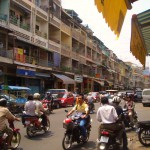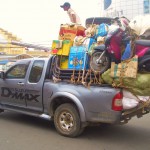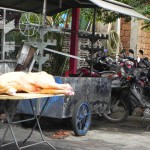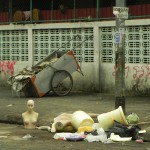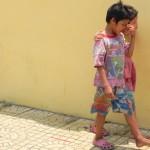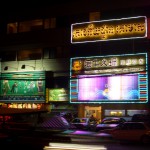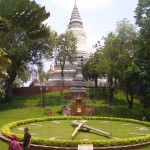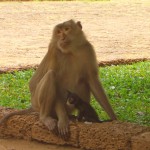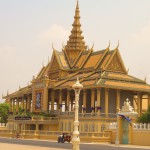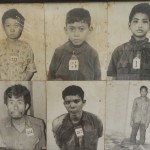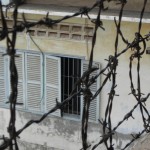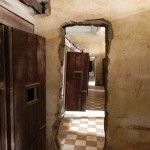Driving alongside Phnom Penh’s riverside at night we thought: Wow, finally a real city! However, our fascination considerably weakened once we found ourselves amidst the turmoil of the hot and crowded capital.
Th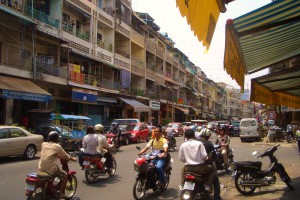 e immense traffic, heat, dust and smog made a walk in the city unbearable. The city is clearly not made for pedestrians, consequently there is no space for walking at all: the pavement is crowded with parked SUVs and local shops open their stands there as well, so you have to walk on the roadside competing with motorbikes, cars and busses honking their horns and heading at you from all directions.
e immense traffic, heat, dust and smog made a walk in the city unbearable. The city is clearly not made for pedestrians, consequently there is no space for walking at all: the pavement is crowded with parked SUVs and local shops open their stands there as well, so you have to walk on the roadside competing with motorbikes, cars and busses honking their horns and heading at you from all directions.
There is literally nothing that you cannot transport on a motorbike: up to 5 people and all their baggage, an entire grilled pork wrapped in newspaper, ice blocks, living chicken tied upside down, a TV set, a kitchen table, or a big basket with watermelons. Tuk tuk- and motorbike taxi drivers shout from every corner trying to grab your attention and to sell you their service, being extremely difficult to get rid of. We were wondering if there are other professions in Phnom Penh apart from these two.
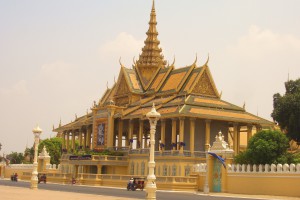 On our walking tour we visited the Royal Palace and the Silver Pagoda, the latter named in honour of the floor, which is supposed to be covered with over 5000 silver tiles. We climbed the 27m-high hill to the summit to see Wat Phnom. Locals pray here for good luck, success, protection or healing. When a wish is granted, the faithful return to deliver the offering they promised to the spirits, such as jasmine flowers or a bunch of bananas.
On our walking tour we visited the Royal Palace and the Silver Pagoda, the latter named in honour of the floor, which is supposed to be covered with over 5000 silver tiles. We climbed the 27m-high hill to the summit to see Wat Phnom. Locals pray here for good luck, success, protection or healing. When a wish is granted, the faithful return to deliver the offering they promised to the spirits, such as jasmine flowers or a bunch of bananas.
On the Wat Phnom site, you could also take short elephant rides, get your bag snatched by monkeys (one even adopted a kitten) and pay to free birds caught in tiny cages. Apparently they are trained to return to their cage afterwards!
Contrary to all this fuss, we also made some real experience that used to happen when getting in touch with Khmer people. They love to chat and practise English with you, which enabled more in-depth conversations, like the one led with Im Sarann. Half Khmer, half Vietnamese, he has eight brothers and sisters and is the only one in the family to have a master’s degree. He told me that he was one of 125 students admissed for a scholarship among the 8000 who applied and we had a chat about some of the Khmer customs and traditions.
We took half a day to visit the Tuol Sleng Museum. In 1975, a High School was taken over by Pol Pot’s security force and turned into Security Prison 21 (S-21). It soon became the largest such centre of detention and torture i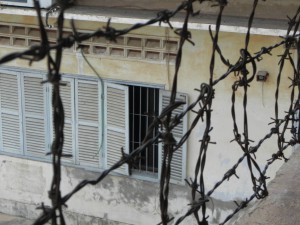 n the country. Over 17,000 men, women and children held at S-21 were taken to the extermination camp (killing field) at Choeung Ek to be executed; detainees who died during a shocking variety of forms of torture were buried in mass graves in the prison grounds. All of this was part of the Khmer Rouge idea of social engineering into an agrarian-based communist society, which however translated into genocide and killing – by torture, execution or starvation – of more than two million people. We spare you the worst pictures from S-21, from which only seven people could be freed alive.
n the country. Over 17,000 men, women and children held at S-21 were taken to the extermination camp (killing field) at Choeung Ek to be executed; detainees who died during a shocking variety of forms of torture were buried in mass graves in the prison grounds. All of this was part of the Khmer Rouge idea of social engineering into an agrarian-based communist society, which however translated into genocide and killing – by torture, execution or starvation – of more than two million people. We spare you the worst pictures from S-21, from which only seven people could be freed alive.
Phnom Penh definitely left us in a thoughtful mood.

